Topamax
Generic name: topiramate
Brand names: Topamax, Topamax Sprinkle
Drug class: Carbonic anhydrase inhibitor anticonvulsants
Medically reviewed by A Ras MD
What is Topamax?
Topamax is a prescription medicine used to treat certain types of seizures (partial-onset seizures and primary generalized tonic-clonic seizures) in adults and children 2 years and older. It is with other medicines to treat certain types of seizures (partial-onset seizures, primary generalized tonic-clonic seizures, and seizures associated with Lennox-Gastaut syndrome) in adults and children 2 years and older. It prevents migraine headaches in adults and adolescents 12 years and older.
Description
Topiramate is a sulfamate-substituted monosaccharide. TOPAMAX® (topiramate) Tablets are available as 25 mg, 50 mg, 100 mg, and 200 mg round tablets for oral administration. TOPAMAX® (topiramate capsules) Sprinkle Capsules are available as 15 mg and 25 mg sprinkle capsules for oral administration as whole capsules or opened and sprinkled onto soft food.
Topiramate is a white crystalline powder with a bitter taste. Topiramate is most soluble in alkaline solutions containing sodium hydroxide or sodium phosphate and having a pH of 9 to 10. It is freely soluble in acetone, chloroform, dimethylsulfoxide, and ethanol. The solubility in water is 9.8 mg/mL. Its saturated solution has a pH of 6.3. Topiramate has the molecular formula C12H21NO8S and a molecular weight of 339.36. Topiramate is designated chemically as 2,3:4,5-Di-O-isopropylidene-β-D-fructopyranose sulfamate and has the following structural formula:
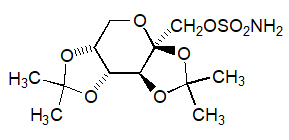
TOPAMAX® Tablets contain the following inactive ingredients: carnauba wax, hypromellose, lactose monohydrate, magnesium stearate, microcrystalline cellulose, polyethylene glycol, polysorbate 80, pregelatinized starch, purified water, sodium starch glycolate, synthetic iron oxide, and titanium dioxide.
TOPAMAX® Sprinkle Capsules contain topiramate-coated beads in a hard gelatin capsule. The inactive ingredients are black pharmaceutical ink, cellulose acetate, gelatin, povidone, sodium lauryl sulfate, sorbitan monolaurate, sugar spheres (sucrose and starch) and titanium dioxide.
Mechanism of Action
The precise mechanisms by which topiramate exerts its anticonvulsant and preventive migraine effects are unknown; however, preclinical studies have revealed four properties that may contribute to topiramate’s efficacy for epilepsy and the preventive treatment of migraine. Electrophysiological and biochemical evidence suggests that topiramate, at pharmacologically relevant concentrations, blocks voltage-dependent sodium channels, augments the activity of the neurotransmitter gamma-aminobutyrate at some subtypes of the GABA-A receptor, antagonizes the AMPA/kainate subtype of the glutamate receptor, and inhibits the carbonic anhydrase enzyme, particularly isozymes II and IV.
What is the most important information I should know about Topamax?
Topamax may cause eye problems. Serious eye problems include:
- any sudden decrease in vision with or without eye pain and redness.
- a blockage of fluid in the eye causing increased pressure in the eye (secondary angle closure glaucoma).
- These eye problems can lead to permanent loss of vision if not treated.
- You should call your healthcare provider right away if you have any new eye symptoms, including any new problems with your vision.
Topamax may cause decreased sweating and increased body temperature (fever). People, especially children, should be watched for signs of decreased sweating and fever, especially in hot temperatures. Some people may need to be hospitalized for this condition. If high fever, a fever that does not go away, or decreased sweating develops, call your healthcare provider right away.
Topamax can increase the level of acid in your blood (metabolic acidosis). If left untreated, metabolic acidosis can cause brittle or soft bones (osteoporosis, osteomalacia, osteopenia), kidney stones, can slow the rate of growth in children, and may possibly harm your baby if you are pregnant. Metabolic acidosis can happen with or without symptoms.
Sometimes people with metabolic acidosis will:
- feel tired
- not feel hungry (loss of appetite)
- feel changes in heartbeat
- have trouble thinking clearly
Your healthcare provider should do a blood test to measure the level of acid in your blood before and during your treatment with Topamax. If you are pregnant, you should talk to your healthcare provider about whether you have metabolic acidosis.
Like other antiepileptic drugs, Topamax may cause suicidal thoughts or actions in a very small number of people, about 1 in 500.
Call a healthcare provider right away if you have any of these symptoms, especially if they are new, worse, or worry you:
- thoughts about suicide or dying
- attempts to commit suicide
- new or worse depression
- new or worse anxiety
- feeling agitated or restless
- panic attacks
- trouble sleeping (insomnia)
- new or worse irritability
- acting aggressive, being angry, or violent
- acting on dangerous impulses
- an extreme increase in activity and talking (mania)
- other unusual changes in behavior or mood
Do not stop Topamax without first talking to a healthcare provider.
- Stopping Topamax suddenly can cause serious problems.
- Suicidal thoughts or actions can be caused by things other than medicines. If you have suicidal thoughts or actions, your healthcare provider may check for other causes.
How can I watch for early symptoms of suicidal thoughts and actions?
- Pay attention to any changes, especially sudden changes, in mood, behaviors, thoughts, or feelings.
- Keep all follow-up visits with your healthcare provider as scheduled.
- Call your healthcare provider between visits as needed, especially if you are worried about symptoms.
Topamax can harm your unborn baby.
- If you take Topamax during pregnancy, your baby has a higher risk for birth defects called cleft lip and cleft palate. These defects can begin early in pregnancy, even before you know you are pregnant.
- Cleft lip and cleft palate may happen even in children born to women who are not taking any medicines and do not have other risk factors.
- There may be other medicines to treat your condition that have a lower chance of birth defects.
- All women of childbearing age should talk to their healthcare providers about using other possible treatments instead of Topamax. If the decision is made to use Topamax, you should use effective birth control (contraception) unless you are planning to become pregnant. You should talk to your doctor about the best kind of birth control to use while you are taking Topamax.
- Tell your healthcare provider right away if you become pregnant while taking Topamax. You and your healthcare provider should decide if you will continue to take Topamax while you are pregnant.
- If you take Topamax during pregnancy, your baby may be smaller than expected at birth. The long-term effects of this are not known. Talk to your healthcare provider if you have questions about this risk during pregnancy.
- Metabolic acidosis may have harmful effects on your baby. Talk to your healthcare provider if Topamax has caused metabolic acidosis during your pregnancy.
- Pregnancy Registry: If you become pregnant while taking Topamax, talk to your healthcare provider about registering with the North American Antiepileptic Drug Pregnancy Registry. You can enroll in this registry by calling 1-888-233-2334. The purpose of this registry is to collect information about the safety of Topamax and other antiepileptic drugs during pregnancy.
What should I tell my healthcare provider before taking Topamax?
Before taking Topamax, tell your healthcare provider about all of your medical conditions, including if you:
- have or have had depression, mood problems, or suicidal thoughts or behavior.
- have kidney problems, have kidney stones, or are getting kidney dialysis.
- have a history of metabolic acidosis (too much acid in the blood).
- have liver problems.
- have weak, brittle, or soft bones (osteomalacia, osteoporosis, osteopenia, or decreased bone density).
- have lung or breathing problems.
- have eye problems, especially glaucoma.
- have diarrhea.
- have a growth problem.
- are on a diet high in fat and low in carbohydrates, which is called a ketogenic diet.
- are having surgery.
- are pregnant or plan to become pregnant.
- are breastfeeding or plan to breastfeed. Topamax passes into breast milk. Breastfed babies may be sleepy or have diarrhea. It is not known if the Topamax that passes into breast milk can cause other serious harm to your baby. Talk to your healthcare provider about the best way to feed your baby if you take Topamax.
Tell your healthcare provider about all the medicines you take, including prescription and over-the-counter medicines, vitamins, and herbal supplements. Topamax and other medicines may affect each other causing side effects.
Especially tell your healthcare provider if you take:
- valproic acid (such as Depakene or Depakote).
- any medicines that impair or decrease your thinking, concentration, or muscle coordination.
- birth control pills. Topamax may make your birth control pills less effective. Tell your healthcare provider if your menstrual bleeding changes while you are taking birth control pills and Topamax.
Ask your healthcare provider if you are not sure if your medicine is listed above.
Know the medicines you take. Keep a list of them to show your healthcare provider and pharmacist each time you get a new medicine. Do not start a new medicine without talking with your healthcare provider.
How should I take Topamax?
- Take Topamax exactly as prescribed.
- Your healthcare provider may change your dose. Do not change your dose without talking to your healthcare provider.
- Take Topamax tablets whole. Do not chew the tablets. They may leave a bitter taste.
- Topamax sprinkle capsules may be swallowed whole or may be opened and sprinkled on a teaspoon of soft food. Drink fluids right after eating the food and medicine mixture to make sure it is all swallowed. Do not chew the food and medicine mixture.
- Do not store any medicine and food mixture for later use.
- Topamax can be taken before, during, or after a meal. Drink plenty of fluids during the day. This may help prevent kidney stones while taking Topamax.
- If you take too much Topamax, call your healthcare provider right away or go to the nearest emergency room.
- If you miss a single dose of Topamax, take it as soon as you can. However, if you are within 6 hours of taking your next scheduled dose, wait until then to take your usual dose of Topamax, and skip the missed dose. Do not double your dose. If you have missed more than one dose, you should call your healthcare provider for advice.
- Do not stop taking Topamax without talking to your healthcare provider. Stopping Topamax suddenly may cause serious problems. If you have epilepsy and you stop taking Topamax suddenly, you may have seizures that do not stop. Your healthcare provider will tell you how to stop taking Topamax slowly.
- Your healthcare provider may do blood tests while you take Topamax.
What should I avoid while taking Topamax?
- You should not drink alcohol while taking Topamax. Topamax and alcohol can affect each other causing side effects such as sleepiness and dizziness.
- Do not drive a car or operate machinery until you know how Topamax affects you. Topamax can slow your thinking and motor skills, and may affect vision.
Label
PRINCIPAL DISPLAY PANEL – 25 MG TABLET BOTTLE LABEL
- NDC 50458-639-65
- TopAMAX®
(topiramate) Tablets - 25 mg
- CAUTION: Verify Prescription
Before Dispensing - ATTENTION PHARMACIST:
Dispense Accompanying
Medication Guide to Each
Patient - Rx only
60 tablets - janssen
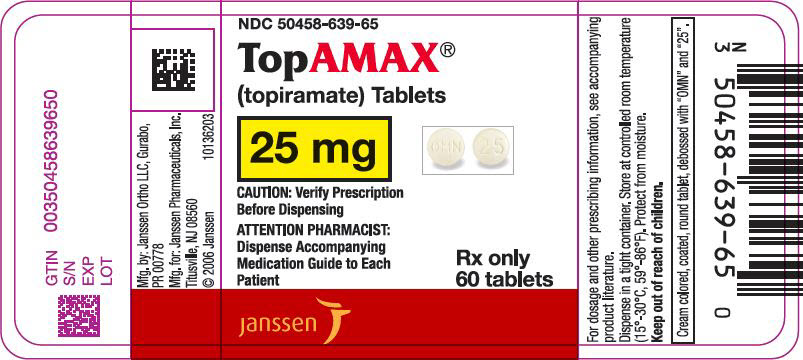

PRINCIPAL DISPLAY PANEL – 50 MG TABLET BOTTLE LABEL
- NDC 50458-640-65
- TopAMAX®
(topiramate) Tablets - 50 mg
- CAUTION: Verify Prescription
Before Dispensing - ATTENTION PHARMACIST:
Dispense Accompanying
Medication Guide to Each
Patient - Rx only
60 tablets - janssen


PRINCIPAL DISPLAY PANEL – 100 MG TABLET BOTTLE LABEL
- NDC 50458-641-65
- TopAMAX®
(topiramate) Tablets - 100 mg
- CAUTION: Verify Prescription
Before Dispensing - ATTENTION PHARMACIST:
Dispense Accompanying
Medication Guide to Each
Patient - Rx only
60 tablets - janssen
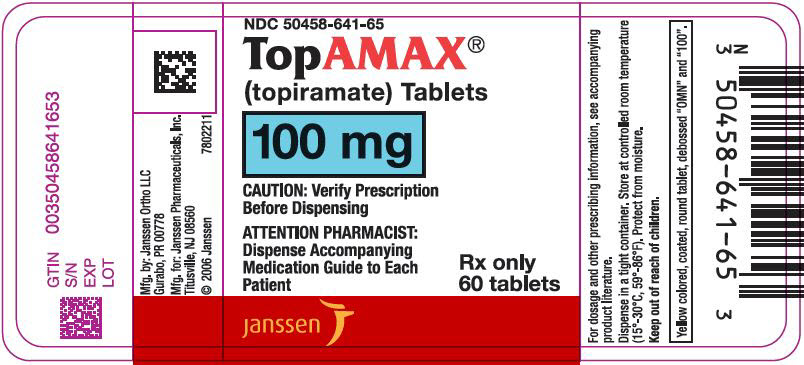

PRINCIPAL DISPLAY PANEL – 200 MG TABLET BOTTLE LABEL
- NDC 50458-642-65
- TopAMAX®
(topiramate) Tablets - 200 mg
- CAUTION: Verify Prescription
Before Dispensing - ATTENTION PHARMACIST:
Dispense Accompanying
Medication Guide to Each
Patient - Rx only
60 tablets - janssen
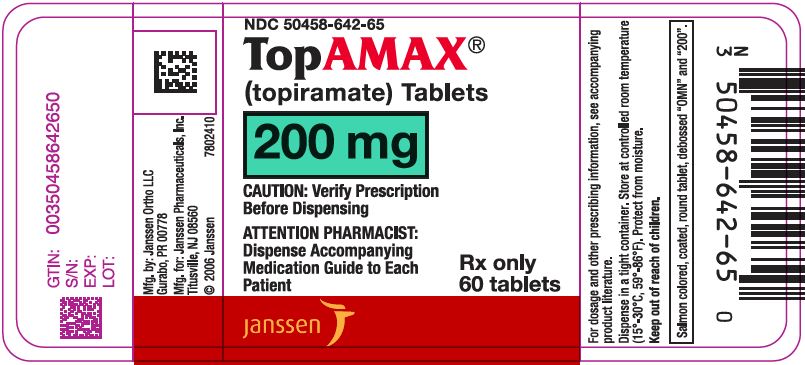

PRINCIPAL DISPLAY PANEL – 15 MG CAPSULE BOTTLE LABEL
- NDC 50458-647-65
- TopAMAX®
(topiramate capsules)
Sprinkle Capsules - 15 mg
- ATTENTION PHARMACIST:
Dispense Accompanying
Medication Guide to Each
Patient - Rx only
60 capsules - janssen
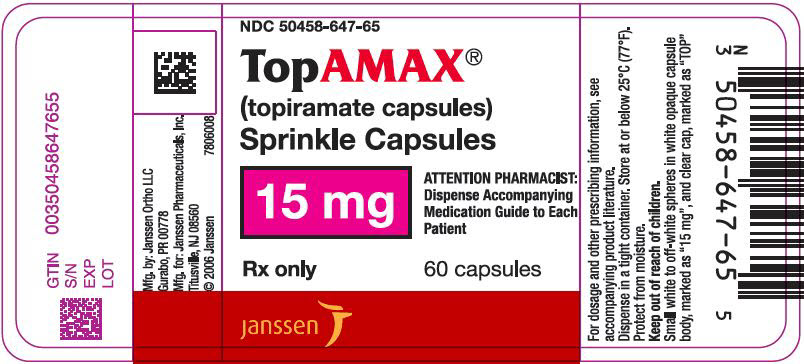
What are the possible side effects of Topamax?
Topamax may cause serious side effects including:
- See “What is the most important information I should know about Topamax?” above
- High blood ammonia levels. High ammonia in the blood can affect your mental activities, slow your alertness, make you feel tired, or cause vomiting. This has happened when Topamax is taken with a medicine called valproic acid (Depakene and Depakote).
- Effects on thinking and alertness. Topamax may affect how you think and cause confusion, problems with concentration, attention, memory, or speech. Topamax may cause depression or mood problems, tiredness, and sleepiness.
- Dizziness or loss of muscle coordination.
- Kidney stones. Drink plenty of fluids when taking Topamax to decrease your chances of getting kidney stones.
- Low body temperature. Taking Topamax when you are also taking valproic acid can cause a drop in body temperature to less than 95°F, or can cause tiredness, confusion, or coma.
Call your healthcare provider right away if you have any of the symptoms above.
The most common side effects of Topamax include:
- tingling of the arms and legs (paresthesia)
- not feeling hungry
- nausea
- a change in the way foods taste
- diarrhea
- weight loss
- nervousness
- upper respiratory tract infection
- speech problems
- tiredness
- dizziness
- sleepiness/drowsiness
- slow reactions
- difficulty with memory
- pain in the abdomen
- fever
- abnormal vision
- decreased feeling or sensitivity, especially in the skin
Tell your healthcare provider about any side effect that bothers you or that does not go away. These are not all the possible side effects of Topamax. Call your doctor for medical advice about side effects. You may report side effects to FDA at 1-800-FDA-1088. You may also report side effects to Janssen Pharmaceuticals, Inc. at 1-800-JANSSEN (1-800-526-7736).
Drug Interactions
A total of 284 medications are known to interact with Topamax. Use the Interactions Checker Tool.
Common Interactions Checks
- clonazepam
- Cymbalta
- gabapentin
- Klonopin
- Lamictal
- omeprazole
- Synthroid
- tramadol
- trazodone
- Vitamin D3
- Xanax
- Zoloft
General information about the safe and effective use of Topamax
Medicines are sometimes prescribed for purposes other than those listed in a Medication Guide. Do not use Topamax for a condition for which it was not prescribed. Do not give Topamax to other people, even if they have the same symptoms that you have. It may harm them.
You can ask your pharmacist or healthcare provider for information about Topamax that is written for health professionals.
How should I store Topamax?
- Store Topamax tablets at room temperature between 59°F to 86°F (15°C to 30°C).
- Store Topamax sprinkle capsules at or below 77°F (25°C).
- Keep Topamax in a tightly closed container.
- Keep Topamax dry and away from moisture.
Keep Topamax and all medicines out of the reach of children.
What are the ingredients in Topamax?
Active ingredient: topiramate
Inactive ingredients:
- Tablets – carnauba wax, hypromellose, lactose monohydrate, magnesium stearate, microcrystalline cellulose, polyethylene glycol, polysorbate 80, pregelatinized starch, purified water, sodium starch glycolate, synthetic iron oxide, and titanium dioxide.
- Sprinkle Capsules – black pharmaceutical ink, cellulose acetate, gelatin, povidone, sodium lauryl sulfate, sorbitan monolaurate, sugar spheres (sucrose and starch) and titanium dioxide.
SRC: NLM .